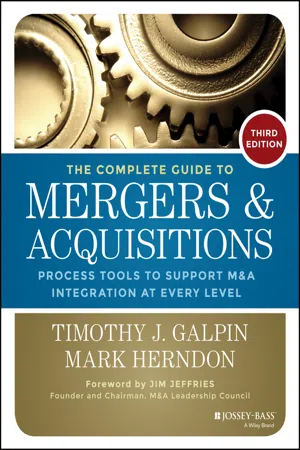
The Complete Guide to Mergers and Acquisitions
Process Tools to Support M&A Integration at Every Level
Timothy J. Galpin
- English
- ePUB (mobile friendly)
- Available on iOS & Android
The Complete Guide to Mergers and Acquisitions
Process Tools to Support M&A Integration at Every Level
Timothy J. Galpin
About This Book
Ease the M&A process with a more effective integration plan
The Complete Guide to Mergers and Acquisitions is the ultimate handbook for planning and managing post-merger integration. Packed full of "how to" guidance, tools, templates and resources that have been put to the test on numerous due diligence and integration efforts around the world, The Complete Guide to Mergers and Acquisitions has been the go-to guide for firms seeking to maximize the value of their deals since the release of the first edition in 1999.
Poor integration management virtually ensures that a merger or acquisition will fail to meet financial and strategic goals. The Complete Guide to Mergers and Acquisitions provides the information that enables firms to quickly and prudently capture projected cost and revenue synergies, and to move the combined organization forward. The book addresses strategic deal considerations, due diligence, integration management, people dynamics and cultural integration, common integration mistakes, communications strategies, and provides actionable steps toward creating measurable, positive results throughout the integration process. The updated third edition contains new information and tools to help firms in any industry manage deals of all sizes, including:
- Results of The State of M&A Integration Effectiveness Survey, 2014
- A new chapter on the M&A process deal stages, with an expanded Deal Flow Model
- Findings of substantial M&A research from various studies in multiple industries and organizations, supporting the concepts presented throughout the book
- New and revised tools and templates for due diligence, integration, and results measurement and reporting
- New case examples of recent transactions
- Highlighted 'Key Principles' throughout each chapter
- A summary of key points at the end of each chapter
- Discussion questions addressing the key themes of each chapter
- A 'rapid assessment' diagnostic regarding the key elements of each chapter, which can be completed for any organization
- A revised chapter on taking your M&A game to the next level – essential requirements for building M&A capabilities into a consistently successful enterprise competency
Merger and acquisition activity across the globe continues to grow, and is also playing a major role in the development of expanding markets. A well-managed integration effort is essential to success, and failure means a tremendous waste in terms of time and money, as well as the rapid destruction of shareholder value. The Complete Guide to Mergers and Acquisitions: Process Tools to Support M&A Integration at Every Level, Third Edition is an invaluable resource to guide firms in managing M&A integration and maximize the value of their deals.
Frequently asked questions
Information
Chapter One
Integration: Where Deal Value Is Realized
It's Merger Monday…
…Among other transactions, another mega-merger was announced today—this morning, industry leader Your Company announced an initial agreement to merge with industry giant Their Corporation. During a joint press conference, the two companies' CEOs described the combination as “a true merger of equals.”
The two went on to state, “It's too early in the deal to begin planning for integration, but we are confident that the new company will be stronger together than either company could be on its own. This combination will benefit everyone involved including our customers, shareholders, and employees alike. We will communicate more about the merger to our stakeholders as we have more information to share. Our plan to combine the two companies is essentially to ease the changes in. We will freeze the two organizations for at least a year and, once things settle down, we'll see what we have in the way of products, operations, systems, and people. Once our employees and customers get comfortable with each other and the new entity, we'll then start integrating the two businesses.”